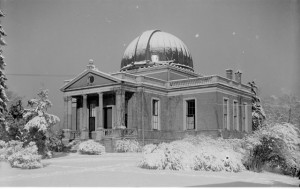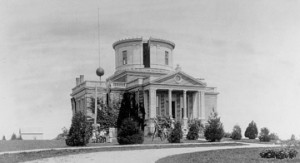My partner and I stopped by the Cincinnati Observatory Center the last time we were in town, even though overcast skies meant conditions weren’t ideal for viewing. Sometimes observatories cancel their public programs on cloudy nights, but the Cincinnati group tries to find something interesting to substitute for a viewing session. So, if you show up to find clouds, you won’t get to use the Merz und Mahler 11″ refractor, but you might hear a good presentation by one of the undergraduate students on her research, look at some of the new images from the observatory’s astrophotography program, or take a historical tour of the main building. The historical tour is also offered every other Sunday afternoon (or so). [Side note: there’s a 16″ refractor, built by the same company that built the 40-inch refractor at Yerkes Observatory, Alvan Clark and Sons, but public education programs usually use the Merz und Mahler telescope.]
Going on that tour is a good idea since Cincinnati is the oldest professional observatory in the U.S. and houses the oldest telescope still in use nightly by the public.
That brings me to my real interest in the site–the Herget building. If you walk around the outside of the main building (the Herget building), you may notice this cornerstone:
Cool, huh? Laid by John Quincy Adams in May, 1843 CE. The only problem is, this is the stone from the original observatory building that was constructed on Mt. Ida (renamed Mt. Adams). The observatory existed at that location until a few years after the end of the Civil War, when the University of Cincinnati took responsibility for the observatory and its existing instruments. Over a period of two years, beginning in 1871 CE, the observatory was moved to its present location on Mt. Lookout, where the old cornerstone was incorporated into a new structure.
The new building was designed by Samuel Hannaford and Sons, a local but prominent architecture firm. If nothing else, the observatory’s Greek Revival design demonstrates the firm’s incredible versatility. Around the same time, Hannaford designed the Renaissance Revival (aka Italianate) Cuvier Press Club Building (1862), his own late Victorian house (1863), the Neo-Romanesque St. George Parish Church (1872), the Neo-Gothic Music Hall (1878), the Neo-Romanesque Nast Trinity Church (1881), the Second Empire Palace Hotel (1882), the god-knows-what-but-looks-vaguely-Pugin-esque Elsinore Arch (1883), and the Queen Anne style Balch House (1896). Sure some of his aesthetic adaptability came from his early training at the firm of Edwin Anderson and William Tinsley (compare Hannaford’s work with Anderson and Tinsley’s Romanesque Revival buildings) and some came from a temporary partnership with Edwin Proctor. Most of his creativity seems to stem from his work with his own sons, though.
Note the original solution for the rotating “dome.” The flat-sided/flat-roofed cupola rotated on bearings fashioned from cannon balls left over after the Civil War. The cupola was replaced with a dome in 1895 CE. Today it rotates electronically, although the viewing door is still operated by rope and pulley.
There’s a second building on the observatory campus, the O. M. Mitchel building. When the 16″ Clark telescope was installed in the main building, the 11″ Merz und Mahler was moved into the Mitchel building. The conical roof on the Mitchel building opened to allow for comet hunting. Nifty, especially in the snow.



